|
|
| History of Renault 1898-1975 |
Louis Renault gambles and wins
|
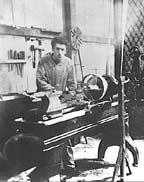
Louis Renault in his workshop |
The story of Renault is first and foremost the story of a man with an unusual destiny. The adventure began on December 24, 1898, when Louis Renault took up a challenge to drive his A-type Voiturette up the steep Rue Lepic in Montmartre, Paris. The exploit won him his first 12 orders. The company continued to grow as Renault began winning road races: Paris-Berlin, Paris-Vienna...
A leader's childhood
Louis Renault was born into a typically bourgeois Parisian family in February 1877. The youngest of five children, he had two sisters and two brothers. His father, Alfred, a conscientious businessman, had built up a comfortable fortune through the sale of fabrics and buttons. His mother, Louise, the daughter of well-to-do shopkeepers, enjoyed entertaining and the arts. Louis was a pampered child. At an early age he developed an enthusiasm for all things mechanical, including engines and electricity everything that surfaced during that era was overflowing with technical progress. The Renault family had a second home in Billancourt, very near to Paris, and it was in a garden shed there that the young Louis set up his first workshop. Studies were not his strong point and he was more than content to pass his baccalauréat. But the quiet teenager had two vital assets for getting on in life: he was both intuitive and practical.
|
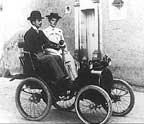
Voiturette, 1898 |
New vehicle moves into gear
At the age of 20, he made a brilliant entrance into the emerging world of the motor car. He converted his De Dion-Bouton tricycle into a small, four-wheeled vehicle and added another of his inventions that would soon propel the motor car into a new era: the "direct drive", the first gearbox. It instantly dethroned the transmission chains and cogs that had been used until then.
On December 24, 1898 Louis was spending Christmas Eve with some friends. Confident about his invention, he bet them that his vehicle could climb the 13% slope of the Rue Lepic in Montmartre. Although they were incredulous at first, his friends were soon forced to believe their eyes. Not only did Louis win his bet - he also pocketed his first 12 firm orders, along with cash deposits. His career was under way. A few months later he filed the patent for the direct drive system that would make his fortune. It was soon adopted by all the manufacturers of the time.
|
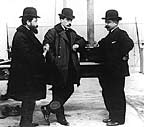
The three Renault brothers |
A string of firsts
His two brothers, Marcel and Fernand, who ran the family business prudently, set up the Renault Brothers company in 1899 - with a small amount of capital and without including their talented sibling. They left Louis the ownership of his patent and paid him a good salary on condition that he show results. In fact, Marcel and Fernand were dubious that the sideline had much future... But Louis was very soon to prove them wrong.
It was through racing that Renault Brothers became known, with Louis and Marcel at the wheels of their vehicles. Starting with the Paris-Trouville event in 1899, they chalked up win after win in most of the city-to-city races, including Paris-Bordeaux, Paris-Ostend, Paris-Berlin and, most important, a magnificent Paris-Vienna won by Marcel in 1902.
|
|
Rapid growth
Those victories were the most effective form of advertising and direct marketing that the brothers could have wished for. An admiring public made their order books fatter with every race.
The cars were sold for 3,000 francs - the equivalent of ten year's average salary at the time. The company expanded rapidly and the workshops by the Seine were forced to expand with it. By 1902 they covered 7,500 square metres. The Renault catalogue included several models, including the first saloon car on the market. In the same year Louis introduced the first Renault engine, with four cylinders and horse-power of 24. Soon after he patented the first turbo.
|
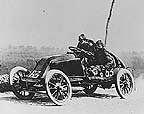
Marcel Renault and his
mechanic, Vauthier,
taking part in the 1903 Paris-Madrid race. |
The end of an era
In 1903 a tragedy occurred: Marcel was killed in an accident during the Paris-Madrid race. He was 31. The race, which had already claimed six other lives and left about 15 people injured, was called off by the national organisers. It was a hard blow for Louis, who lost not only a brother but also his most loyal supporter. He gave up racing for good and passed on to professional drivers the task of defending the Renault company colours, in France as well as North Africa, the United States, Cuba and South America. It was also around this time that Fernand started to establish the Renault Brothers sales network and to set up the company's first subsidiaries abroad in England, Belgium, Italy, Germany, Spain and the United States. |
A decisive step
|
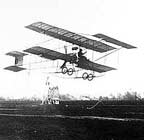
A Farmann-Renault plane |
In 1905, to meet orders for taxis placed by the cities of Paris, London and New York, Renault switched from craft production to mass production. During the first world war, the Billancourt plant worked flat-out to produce vehicles for the troops. The FT 17 tank made a decisive contribution to the Allies' victory... and to the fame of Louis Renault, who had designed it. When peace returned, France's leading manufacturer set to work to relaunch civilian production.
First steps in manufacturing
1905 marked a turning point after Renault received an order for 250 taxis. The premises were reorganised and the company switched from workshop to mass production. Renault became the leading French car manufacturer. The taxis were a huge success, both in Paris and in London where, two years later, every other taxi was a Renault. They were even exported as far away as New York and Buenos Aires.
|
|
Alone at the helm
In 1909 Fernand died after a long illness. He had already sold his stake in the company to his brother and it was renamed the Louis Renault Automobile Company. At 32, Louis was alone at the helm and was still brimming over with new ideas. His cars were growing increasingly powerful, and he made vans, small buses, generators - anything that contained an engine, in fact. But he was also becoming known in a brand new field that aroused his enthusiasm just as much as cars did: aviation. Two years earlier, he had been the first car manufacturer to move into aeronautics. His engines were now beating record after record in the air.
|
|
The first strikes
The factory was burgeoning visibly in a tangle of workshops spread over 136,000 square metres. In 1913 the company suffered its first strikes: the new working method that was supposed to increase productivity, known as Taylorism, was not to the workers' liking. Louis had brought the method back from the United States, where he had observed its effectiveness at Ford, which was now a formidable competitor to Renault with its single, inexpensive model, the Ford T.
On the eve of the first world war, the Renault factory had about 5,000 employees, producing 4,200 vehicles a year. Many of the men were called up and their wives took over their jobs.
|
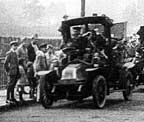
A "taxi de la Marne" |
The Marne taxis
War broke out in 1914. Among the Parisian taxis requisitioned to take 4,000 soldiers to the front, 500 Renaults (or were there 110, contrary to the legend?) helped achieve the first victory over the Germans. They went down in history as the "Marne taxis". Renault factories switched from making cars to helping the war effort and in four years the company produced impressive quantities of all kinds of equipment trucks, ambulances, stretchers and more than 8 million shells (although Citroën made 24 million!). Renault became the leading manufacturer of aeroplane engines (14,500) and also supplied the Allies, including the Russians from the company's factory on the Volga. The company also built its first plane.
|
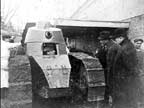
A Renault FT 17 tank |
The tanks of glory
Finally, in 1917, Louis Renault designed the first light armoured tank, the famous FT 17. Its outstanding qualities enabled the Allies to break through the German lines and win the final victory in 1918. The future American general, George S. Patton, gave the FT17 a huge advertising boost by driving one to the front.
Louis Renault was covered with honours for his unique contribution to the war effort. He had acquired an international reputation, the conflict was a powerful force in the expansion of his company and he was now the number one private manufacturer in France. But once peace returned, other battles were waiting to be fought ... |
An unstable world
|
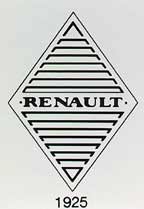
1925 : Renault's first diamond logo |
The United States, which was not involved in the war, overtook France to become the world's leading automobile manufacturer. Against a background of economic chaos, Louis Renault diversified production, making buses, tractors and light commercial vehicles. He introduced a new form of work organization to reduce his dependence on other companies, and built a huge factory on the Ile Seguin, Billancourt, just outside Paris
The Americans' lead
In 1919 Louis Renault assessed the gap that separated European automobile manufacturers from their American rivals. The United States, which was not involved in the war, had already entered the consumer era. Thanks mainly to Ford, which was mass-producing inexpensive vehicles, more people could afford cars, and making them had become a major industry with repercussions on the national economy. In France, the motor car was still regarded as a luxury and was heavily taxed, which was holding back its progress. The golden age of the French automobile was a thing of the past.
|
|
The weapon: "A large-scale organisation"
After the first recession that rocked the world economy in 1920-1921, Louis Renault reorganised his business. He set up the Société Anonyme des Usines Renault (SAUR), sold a stake in the company to a bank and worked out his view of "a large-scale organisation" that would be strong and independent, a sort of autarkical stronghold that could face up to the competition and stay afloat when the economy was going through a depression. Like Ford, which had gone as far as buying its own railroad, the SAUR became an "all-in-one" firm with an extraordinarily varied range of production units and sites. This is known as "vertical concentration" - the exact opposite of Renault today, which focuses on its core business of making cars and buys in about 80% of the components.
|
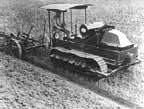
A Renault tractor |
Renault was everywhere
Peace, with lost time to be made up for and needs to be satisfied in many areas, gave Louis Renault a tremendous boost of creativity. He manufactured everything that had an engine: cars, light commercial vehicles, vans, buses and trucks, farm tractors (whose caterpillar tracks were inherited from wartime tanks), ships' engines, motor units, railcars and, of course, aeroplane engines. To supply the workshops, he acquired his own foundries, ironworks, sandpits, forests and sawmills, enabling him to make everything that would reduce his dependency on other companies: steel, cardboard, electrical equipment, industrial rubber, oil and lubricants. He did buy in components when they were cheaper than those he could make himself, and of the required quality.
|
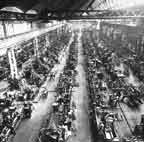
The Billancourt plant |
The factory island
The Billancourt plant was at the centre of the system, but its labyrinth of workshops did not allow vehicles to be mass-produced, American-style. In Paris, on the other side of the River Seine, André Citroën already had a modern factory complete with assembly lines, which were not introduced at Renault until 1922. Louis Renault built his big factory on Seguin Island, Billancourt, where he had been planning to lay out recreation areas for his workers. After a long series of legal manoeuvres, he managed to buy plot after plot of land... except for one which the owner stubbornly refused to sell him. No matter, the first assembly line started working in 1929 and the factory was completed in 1937. |
Renault takes off
|
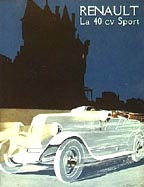
Advert for the 40 CV Sport |
With society changing radically, the range expanding, racing records and rivalry with Citroën, Renault grew internationally, moving into 49 countries. Despite the 1929 stock market crash and the ensuing recession, the brand began to show signs of strength which would be consolidated in the 1930s.
Renault and Citroën
The turbulent post-war period was also the backdrop to fierce rivalry in France between the two leading automobile manufacturers, Citroën and Renault. Despite huge differences, they shared the same determination to succeed. They became competitors in all areas. Citroën, won over by American methods and more keen on new ideas, set about producing inexpensive, small-engine models. It was also the first car manufacturer to make widespread use of advertising and the first to introduce sales on credit, followed closely by Renault. When Renault embarked on making taxis, Citroën did the same; one company set up a bus division, the other did likewise. They fought the same battle in Africa during the long-distance trekking adventure.
|
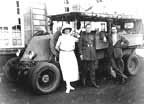
The 1925 Delingette expedition: 23,000km across Africa in Renault six-wheel trucks |
The era of records
Renault engineering was everywhere - on the ground, in the air and on water - and continued to beat records. Paris-Warsaw in 43 hours non-stop in a 10CV, beating the "Nord Express" by five hours, in 1922; a world water-speed record of 140 kph for a Farman hovercraft with a 300CV Renault engine; a world altitude record in 1923 for a Bréguet-Renault (5,381 metres with a payload of 500 kg), then, two years later, a non-stop distance record (3,166.3 km in 24½ hours). In 1928 Jean Mermoz flew over the Andes in a Latécoère 25 fitted with a Renault engine. Renault cars set new records too: a fuel economy record in Finland in 1925 with a 6CV doing 100 km on 3.6 litres, and, in the same year, a world land-speed record in a 40CV that covered 3,385 km in 24 hours on the Montlhéry circuit, near Paris, at an average 141 kph, while another 40CV won the Monte Carlo Rally ...
|
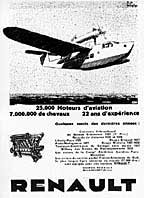
Advert for Renault aircraft
engines |
Meanwhile, back in the factories ...
They may have been the Roaring Twenties for some, but for others they were the Worrying Twenties. In the factories, working conditions were making no progress, apart from the eight-hour day approved by parliament in 1919 and social insurance, voted in 1928. With the progress made in mechanisation, the introduction of assembly lines and the increasing amount of work done by machines, people became interchangeable. Trade unions, with low membership rates and poor organisation, were in no position to stand up to the bosses, who asserted that wage claims were unacceptable in those times of economic instability and increased competition. Indeed, from 1929 on, Louis Renault responded to the depression by cutting both wages and staff numbers.
Renault worldwide
Between 1919 and 1929 Louis Renault set up about 30 subsidiaries abroad and established a presence in the French colonial empire, in Africa and the Far East. To make up for the loss of the company's Russian factories, which had been swallowed up by the Soviet Union, he opened two new plants: at Haren/Vilvoorde, Belgium (1926) and Acton, England (1927). By 1929 the Renault brand was represented in 49 countries and all the continents except Australia... but American manufacturers were still responsible for 85% of automobile production worldwide.
|
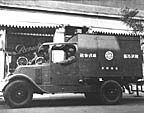
A delivery truck in front of a Renault agency in china (1930) |
No more illusions
In New York, the spiral of stock market speculation ended dramatically when Wall Street collapsed, on Thursday, October 24, 1929. Millions of people in the United States found themselves penniless and homeless. The shockwave spread round the world, bringing in its wake a sudden worsening of unemployment and the rise of totalitarian governments. In Germany, it provided a springboard for Hitler, who planned to subject the whole of Europe to the "cure" described in "Mein Kampf". |
The end of an era
|

Reinastella 32CV 8 cylinders convertible - 1930 |
At the summit of his glory, Louis Renault was completing his lifetime's work but he was no longer in tune with the times. And in 1940, he did not understand the shape history was taking. When he died in 1944, his company was nationalized for being "an instrument of the enemy".
The effects of the Wall Street crash
Europe was hard hit by the repercussions of the recession in the United States, which had a knock-on effect all over the world. The automobile industry, which was highly sensitive to economic disorder, had to find a new strategy. American manufacturers, who accounted for 89% of world production, carried out mass sackings. They also learned to produce more efficiently and at less cost, and started expanding abroad. In Europe, governments played a vital role in defending and promoting their national brands through a series of measures focusing specifically, as in France and Italy, on taxing imported vehicles heavily.
|

Caudron plane - 1934 |
Renault's response to the crisis
To cope with the crisis, Renault made a major productivity and cost-cutting effort while reducing salaries and staff numbers, which also led to strikes by rota. Meanwhile the company stepped up the diversification of its production, particularly in public transport vehicles such as buses and electric railcars. But it also relied on orders for weapons, mainly by developing the aeronautical side of the business. Louis Renault bought Caudron, acquired a stake in Air France and helped to set up Air Bleu for postal transport in France.
|
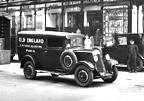
RY2 type van, 8CV,
6 cylinders - 1930 |
The arrival of small cars
In Italy, Germany and the United Kingdom, automakers had understood that if they were to survive they would have to make affordable cars for a wider public. They counted on small cars that were inexpensive to buy and to run. The Fiat 500 and above all the legendary Volkswagen designed by Ferdinand Porsche were to enjoy a spectacular degree of success. In France, despite government pressure, Renault, Citroën and Peugeot underestimated demand and failed to reach an agreement on a joint 5CV proposal. Peugeot eventually took over the vehicle with the 202. It was only after the war that France saw the arrival of the true "people's car".
|
|
The end of a great créateur
In 1934 Citroën launched front-wheel drive - a feat of technology, innovation and daring. But André Citroën had more foresight than management skills, and he filed for bankruptcy when the banks finally abandoned him. He died the following year. The French government urged Louis Renault to take over the company run by his fiercest rival, but he refused. The two firms were miles apart culturally as well as financially, and Louis Renault was doubtless apprehensive about trying to merge them. In the end it was Michelin which took over the reins of Citroën.
|
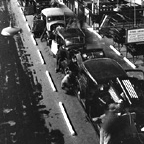
General view of the railcar
assembly workshop on
Ile Seguin - 1936
|
Labour relations deteriorate
The deflationary measures introduced to deal with the crisis increased tension in labour relations. In February 1934 an anti-parliamentary demonstration in Paris left 17 people dead and the unions called for a one-day strike. At Billancourt, two people were killed when police intervened.
By 1935 France had more than half a million unemployed. National automobile production plunged by 35% compared to 1929. With few orders coming in and export markets closing, Renault cut the working week to just 30 hours. Louis Renault, an authoritarian style of boss of the old school, was not one to negotiate his way out of a dispute.
|
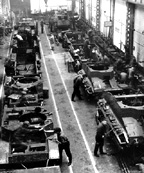
Tank assembly workshop in Billancourt - 1935 |
Renault, a bastion of the workers' struggle
After the People's Front won the parliamentary elections in April 1936, the trade union protest movement continued to grow, gradually bringing all sectors of the economy to a halt. With the highest concentration of strikers in the country assembled at Billancourt, Renault became the core of the workers' struggle in France and remained so for some time. In that same year, 1936, production reached a record of 61,146 vehicles, yet the SAUR (Renault factories' limited company) recorded a large loss, the first in its history. |
Billancourt comes back to life with the 4CV
|
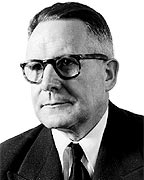
Pierre Lefaucheux |
In 1945, after five years of foreign occupation and hardship, France enters into a period of post-war reconstruction. Renault is emblematic of the nationalization programme launched in the country's main sectors and meant to put France's economy back on its feet.
A Chairman with an iron fist
On January 16, 1945, an ordinance established that the Société Anonyme des Usines Renault was to be nationalized, becoming the Régie Nationale des Usines Renault (RNUR). The French government appointed Pierre Lefaucheux as the company's first Chairman. Engineer and graduate of the prestigious Ecole Centrale, active in the Resistance and with a strong industrial background, this energetic, enthusiastic leader of men quickly settled into this prominent role. He won a first major victory for the future of the company when the new state authorities having decided that Billancourt would concentrate solely on the production of trucks, he managed to gain authorization to manufacture passenger cars as well. Despite a difficult time getting the plant back into working order, the 4CV project was launched.
|
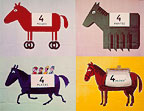
4 wheels, 4 doors, 4 seats, 424,000 francs" - Drawing by Raymond Savignac |
The 4CV
Outlined while France was in the throes of war, and finalized during the post-war rationing period, this little "everyman's vehicle", designed by the engineer Ferdinand Picard, was sturdy, discreet and inexpensive. Pierre Lefaucheux was convinced that small cars were the best way to revive the country's automobile industry. Other manufacturers, such as Citroën, Fiat, Morris and, of course Volkswagen, also took this direction, launching their own small cars. The 4CV (760 cm3) was unveiled at the first Paris Motor Show in 1946 and its mass production, which began the following year, continued up through 1961. The car's huge success far surpassed all expectations. Exported from 1947 onwards, the 4CV was the leading source of foreign income.
|
|
Transfer machines
During this time, the company was equipped with transfer machines, high-performance work tools for engine block machining. They were designed by Pierre Bézier, a Renault engineer who, while a prisoner of war in Germany, improved upon the automatic machine principle introduced before the war by GM (General Motors). With their multiple workstations and electromagnetic heads, these mechanical monsters, precursors of robots, made it possible to perform a variety of different operations consecutively on a single part by transferring it from one station to another. The RNUR sold a number of these machines to competitors in France, the USSR and even the US. Bézier was later responsible for designing the famous curves used around the world for CAD (computer-aided design).
|
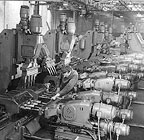
Transfer machine (for housing and cylinder machining) |
Renault at the heart of labour unrest
Despite the reforms undertaken within the framework of the company's modernization and equipment plans, France's economy remained unstable. Shortages and necessities linked to the country' reconstruction efforts lead to inflation and labour unrest. 1947 was marked by strikes and violent demonstrations, especially at the Régie Renault, and the government's Communist-party ministers were forced to resign. Renault, a company in which the CGT union was predominant, became a bastion of worker struggle and unrest, despite the fact that Pierre Lefaucheux was a Chairman open to labour relations (he was the first to set up a Works Council and to open the Board of Directors up to staff representatives). |
Expansion
|
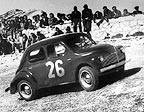
Mont-Ventoux rally -
September 1948 |
The Régie Nationale des Usines Renault (RNUR) goes international, speeding up exports, and Renault once again becomes the leading brand in France. For its ten-year anniversary, the company has already produced 1 million vehicles.
Return to the circuits
With the return of peacetime and the success of the 4CV, motor sport - a long-standing activity for Renault - returns to center stage. In 1948, in the Mont Ventoux race in the South of France, the five competing 4CVs take the first five places, and at the Monte Carlo rally five Renault vehicles again take the top five positions. In 1951, a 4CV specially fitted for the Le Mans 24 Hour race comes in first in its category. That year, Pierre Lefaucheux decides to create a Competition Department, which would later become Renault Sport.
|
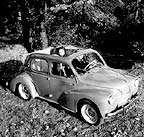
Convertible 4CV (1950 model) |
New operations in France...
The RNUR not only manufactured the 4CV, but also Juvaquatre, heritage of the past, as well as light commercial vehicles, trucks and tractors. Many of its supplies were imported, but as a "Daughter of the Nation", it was the company's duty to create jobs. Renault purchased ball bearing, automotive, engine repair and sawmill facilities. Billancourt had become too small for the company, so additional sites were acquired (for example, Rueil-Malmaison for the Research and Development centre), as well as land on which to build new sites. The Flins plant, near Paris, was inaugurated in 1952 and manufactured the Frégate, RNUR's newest model. At Lardy, in the Paris region, a test centre would later be set up, and at Cléon, near Flins, a powertrain plant was built.
|
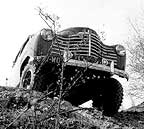
Colorale prairie 4x4 (1951) |
...and abroad
Pierre Lefaucheux had ambitious plans for the RNUR outside France. The Belgian plant at Haren-Vilvorde was once again functioning and would soon be expanded and the company acquired the Acton plant in England. The 4CV was already being assembled in Ireland, Australia, India, Mexico, South Africa and would also be assembled in Japan by Hino until 1960. In 1953, Spain and the FASA, also came into the picture. Pierre Lefaucheux also planned to create plants in the countries of the Union Française, in Vietnam and the Maghreb, in order to position the RNUR on the colonial markets.
|
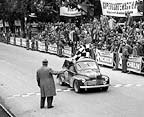
The Garnieri-Bracalion
4CV team at the 1954 Mille Miglia
|
10th anniversary
At the end of 1954, the record-breaking 500,000th 4CV was produced by Renault. The company had 51,000 employees and fulfilled 35% of national automobile production. Of the over 200,000 vehicles produced (of which close to 160,000 passenger cars), over a quarter were assembled outside France and the foreign network included 1,000 sales outlets. But the country's leading car manufacturer was faced with diversification and range upgrade problems against competition from Peugeot and Citroën. The Dauphine was ready to roll. But Pierre Lefaucheux would not live to enjoy the car's success - he was killed in a car accident on February 11, 1955. Pierre Dreyfus was his successor. |
Corporate planning and export
|
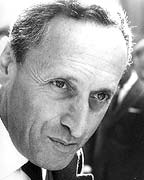
Pierre Dreyfus, head of the Régie Renault from 1955 to 1975 |
Headed by Pierre Dreyfus, the Régie Renault pursues its development and consolidates its position as the leading national firm. However, with insufficient preparation, it fails to gain ground on the U.S. market.
A high-ranking civil servant becomes an industrialist
When Pierre Dreyfus replaced Pierre Lefaucheux at the Régie Renault on March 27, 1955, he was no newcomer to the company, as he had been its vice president since 1948. His goal was to prove that a nationalized company was "as much of a fighter as a private one, and just as successful". He based his strategy on two main ideas: corporate planning , in order to clearly define the direction the company would take and how it would get there, and exporting half of the company's production, to ensure growth. But before he could do this, he would need to restore peaceful industrial relations.
|
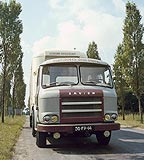
Saviem JL20 truck
|
The Régie Renault, a leader in social progress
Pierre Dreyfus wanted the leading national firm to be exemplary in every way. As early as September 1955, he signed a first corporate agreement ensuring open discussions with the unions and introduced another innovation - a third week of paid holiday . Also in 1955, he raised salaries by 4% and established paid bank holidays and complementary retirement insurance. Renault became a stronghold of social progress as well as a symbol of protest during the social upheavals of May 1968.
Concentration in the heavy goods sector
While Pierre Lefaucheux had begun negotiations, it was Pierre Dreyfus who finalized the agreement which brought about the merger of two heavy goods manufacturers, Latil and Somua, with Renault trucks, creating a new entity, the Saviem. This company was in competition with Berliet, a company which had entirely refused negotiations with the Régie Renault. This situation would soon change, and in 1974 Berliet would join forces with Renault to establish a major player in the heavy goods sector.
|
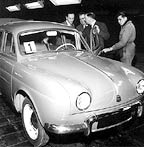
Unveiling of the first Dauphine to Pierre Dreyfus - October 1955
|
The Dauphine takes over
The 4CV was ten years old. Its successor, the Dauphine, launched in 1956, would become an instant success both in France and abroad. Starting in 1957, the Dauphine sold extremely well, far beyond all expectations, on the vast U.S. market - considered by Pierre Dreyfus to be essential to the company's growth. To accommodate the U.S. demand and ship the cars across the Atlantic, Renault created the CAT (Compagnie d'Affrètement et de Transport) freight transport company. In 1959, more Dauphines were sold in the U.S. than were Volkswagen Beetles!
The end of the American dream
Faced with the success of small foreign cars at home, the United States began importing cars manufactured in Europe by their own subsidiaries. In addition, the nascent economic recession began to take its toll on the automobile industry as a whole. The Renault distribution network, set up in haste and lacking any stable partners, soon began to show its weaknesses. As did the Dauphine itself, which proved insufficiently robust. Sales nose-dived, stock was sold off export shipping activity to the U.S. ceased. In 1960, the Régie Renault was faced with the first serious crisis in its history.
|
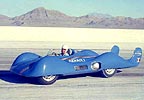
The Etoile Filante beats the speed record at 308.9 kph on the Great Salt Lake - 1956 |
Repercussions
The crisis would have strong repercussions on both a financial level - debts needed to be paid off - and industrially - production was thrown completely off balance - but most importantly in the social realm, when a series of major labour strikes hit the plants after the laying off of 3,000 employees in France and Belgium. The recession only made matters worse and the tensions would only begin to let up with the arrival of new social advances at the end of 1962 - a fourth week of paid holiday, additional time off for seniority, etc. |
New directions
|
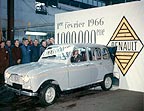
Over 9 million units of the Renault 4 would be sold |
The Régie Renault develops new partnerships and refocuses its energies on Europe, while expanding the range and introducing major innovations.
Innovative new ideas - the Renault 4 and Renault 8
On July 7, 1961, the last 4CV came off the production line. As for the Dauphine, despite 1.5 million production units already behind it, the car could no longer keep up with the times. And so the Renault 4 was unveiled in September 1961. This innovative new model featured five doors, front-wheel drive and true versatility.
The following year, the Renault 8 was launched, equipped with a world first - four disc brakes. With it, Renault's reputation as a small car manufacturer was strengthened and ensured for the future.
|
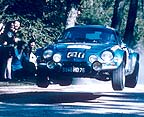
In 1973, the legendary Alpine Berlinette won the Rally World Championship |
Renault and Gordini - a winning combination prepares the way for F1
Following in the footsteps of the 4CV, the Dauphine went on to win a number of rally trophies, thanks to the powerful engines of Amédée Gordini, the mechanical "genius" with whom Renault joined forces before buying his company in 1969. The Renault 8 Gordini won its first race in 1964 in the Tour de Corse. The car ended its brilliant career in 1970, succeeded in both rally and track racing by the Alpine , designed by racecar driver Jean Rédélé. On its way to becoming a legend, the Alpine and its widespread reputation served to boost the Renault name, and paved the way to the Le Mans 24-hour race and Formula 1 racing.
Partnerships - a solution
The Régie Renault was not a wealthy company, since the French government, as its only shareholder, did not make any capital contributions to it. After the failure of the Dauphine in the US, Renault had learned that without sufficient investment capacity, its external growth would have to depend on solid local partnerships. There were two reasons for this: first, in order to gain a more accurate picture of the markets, and second, to ensure less expensive distribution and after-sales service for vehicles exported both built-up and completely-knocked-down and assembled at the partner's plant, within the framework of reciprocal agreements.
|
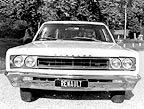
AMC's Rambler, assembled by Renault in Belgium. |
International agreements...
In 1961, negotiations began for a first partnership agreement with AMC, the fourth-ranking US car manufacturer, but they were never finalized. While factors such as decolonization and the ensuing conflicts (Indochina, Africa, Algeria, etc.) contributed to the failure of a number of projects, Renault did enter into a number of international cooperative ventures. Some of these partners would later become subsidiaries of the group - in Argentina, Mexico, Colombia, Turkey, Romania and the USSR. Because of insufficient resources, Renault's stake in one of its partners, Willys Overland do Brazil, was sold to Ford in 1968 (the Renault 12, sold along with the WOB plant, would become the Ford Corcel). Renault would not return to Brazil until thirty years later.
|
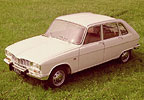
In 1965, the Renault 16
is the first car to be named "Car of the Year" by a European panel |
...and refocusing on Europe
Pierre Dreyfus strongly believed in the new Europe which was beginning to take form and in which Renault, already present in Belgium and Spain, would necessarily have to evolve. The process of concentration taking place in the European automotive industry, with a number of acquisitions and mergers, incited Mr. Dreyfus to seek an ally for the Régie Renault. While negotiations with Volkswagen did not bear fruit, an agreement was made in 1958 with Alfa Romeo and then terminated. Finally, in 1966, Renault entered into a technical cooperation agreement with Peugeot (without cross-shareholdings), which would expand into a three-way agreement with Volvo in 1971 within the framework of the Société Franco-Suédoise de Moteurs. |
Renault in a changing society
|
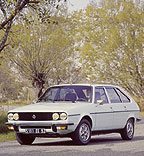
The Renault 30 TS is
equipped with the Régie's first V6 engine |
At the end of the 1960s, a vast protest movement sweeps France in reaction to the capitalist economy and the negative consequences of growth. Then in 1973, the automotive industry, already under fire, is hit hard by the first oil crisis. Renault, however, is spared for the most part.
1968 at the Régie Renault
In May 1968, Renault became the barometer of social unrest in France. Following a 33-day strike with occupation of the plants, workers obtained wage hikes, a one-hour reduction in their working week and an agreement on the exercising of union rights. However, the arrival of immigrant workers (over 16% of the company's 76,000 employees) and the automation of tasks as well as the establishment of new management methods had profoundly transformed the nature of labour relations. Tensions would not subside until 1985.
|
|
The range expands toward the high end
While a commercial strategy centred on small cars makes for high sales volumes and increases a company's market share, Renault decided in the mid-sixties to add more sophisticated models to their range, with the intention of generating higher margins. Renault inaugurated its up-range move with the Renault 16 in 1966. Its concept was entirely new: an innovative saloon-estate model with a rear hatch and a modular interior which made it the precursor of Renault's voitures á vivre. One million units of the car had already been sold by 1972. The range then further expanded with the arrival of both the Renault 15 and 17 coupés, which would win over many new customers, before evolving further upward to the luxury segment with the Renault 20 and 30.
|
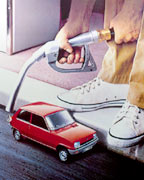
With its low fuel consumption, the Renault 5 comes out a winner during the oil crisis |
Renault 5 - jackpot!
Despite this up-range move, Renault did not neglect the small car market. On the contrary, their small-car range was renewed regularly and with great enthusiasm. First, with the Renault 12 (representing 40% of sales in 1972), and then with the Renault 5 , launched in early 1972. The latter, a modern, economical runabout with innovative front and rear composite bumpers , immediately became a huge commercial success. The vehicle was especially appreciated by women and the under-35 age range, and in the months following the 1973 oil crisis, the Renault 5 represented 60% of the company's sales.
Oil crisis
In October 1973, the Yom Kippur War, launched against Israel by Egypt, was an effective way for the Arab countries to exert political pressure: if Israel did not withdraw from the territories it had been occupying since 1967, the countries supporting it would be deprived of oil. In a few months' time, the price of a barrel of crude rose from US$3 to US$11.65 . Of course, the automobile industry was the first sector affected by this upheaval in the world's economy. As markets collapsed and investments were curbed, range renewals were put off indefinitely. Small, light, fuel-efficient cars like the Renault 5 suddenly become a very attractive solution. Saving energy had become an absolute necessity.
|

Alpine A 310 V6 |
Renault diversifies its business activities
The automobile industry is very sensitive to fluctuations in the economy, especially in times of crisis. Because of this, Renault chose to increase its diversification efforts in order to ensure at least half of its revenues in non-automotive sectors. Diversification was implemented in both industry - Renault Marine already existed, and Renault Moteurs Développement, once created, went on to take over Vélosolex and took a stake in Micmo-Gitane bicycles - and in the commercial sector, with somewhat risky investments in the agro-food business, etc. At the same time, the company sought to penetrate those automotive markets which were the least affected by the crisis.
|
|
An innovative financial policy
Starting in 1963, the Régie Renault gradually began to develop its sales financing business. This new branch was held back however by French legislation which greatly limited the activities of companies with international ambitions. By using fifteen or so different entities grouped together under two holding companies to prospect for external financing, the Régie Renault was able to pursue its international strategy and to ensure a dependable additional source of profitability. In the space of 20 years, the financing branch was responsible for a five-fold increase in the real value of the company. Unfortunately, however, this would not be sufficient...
|
|
|